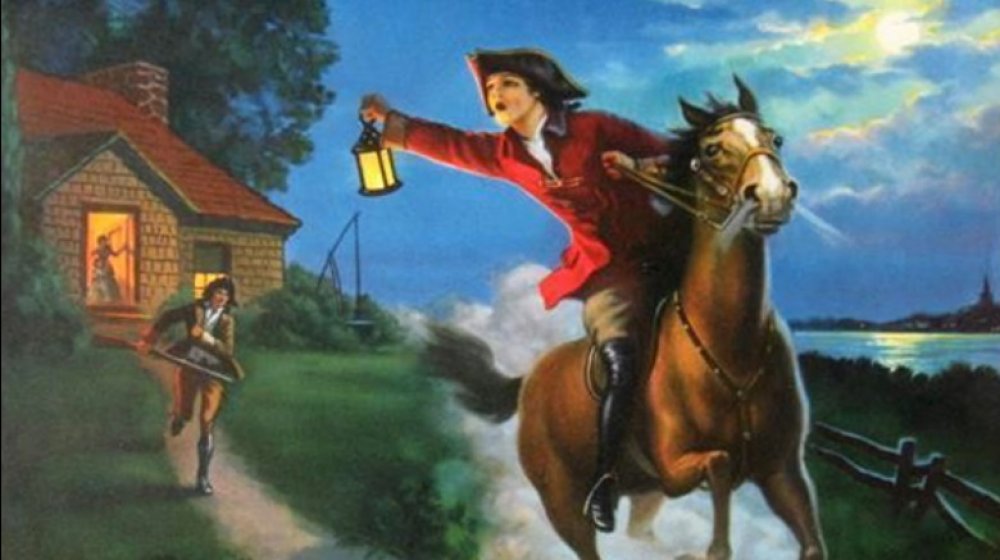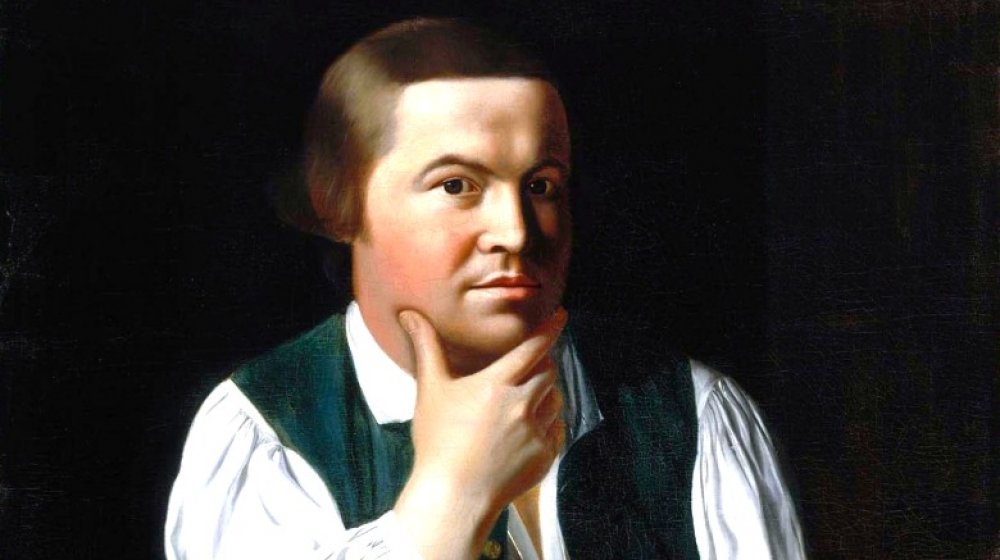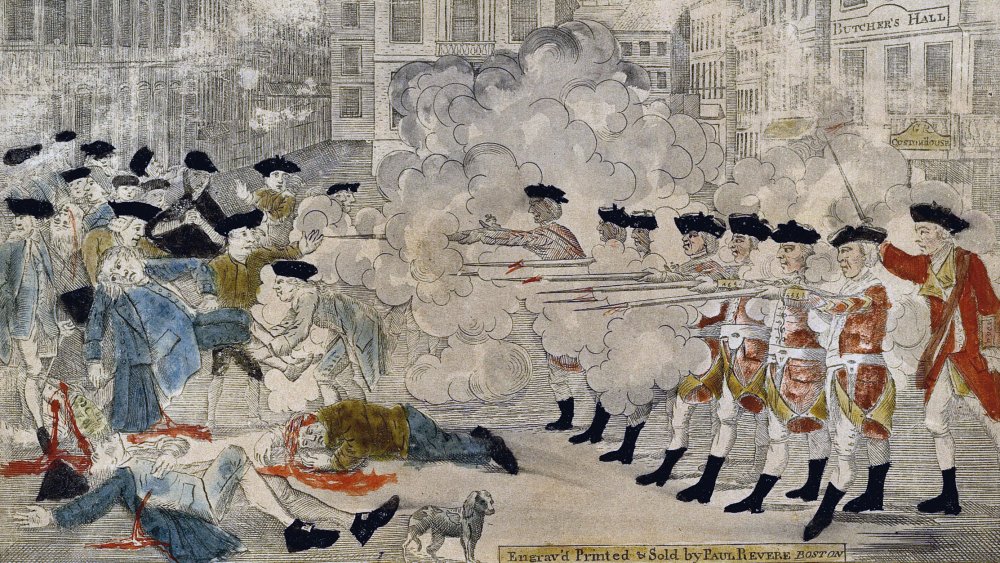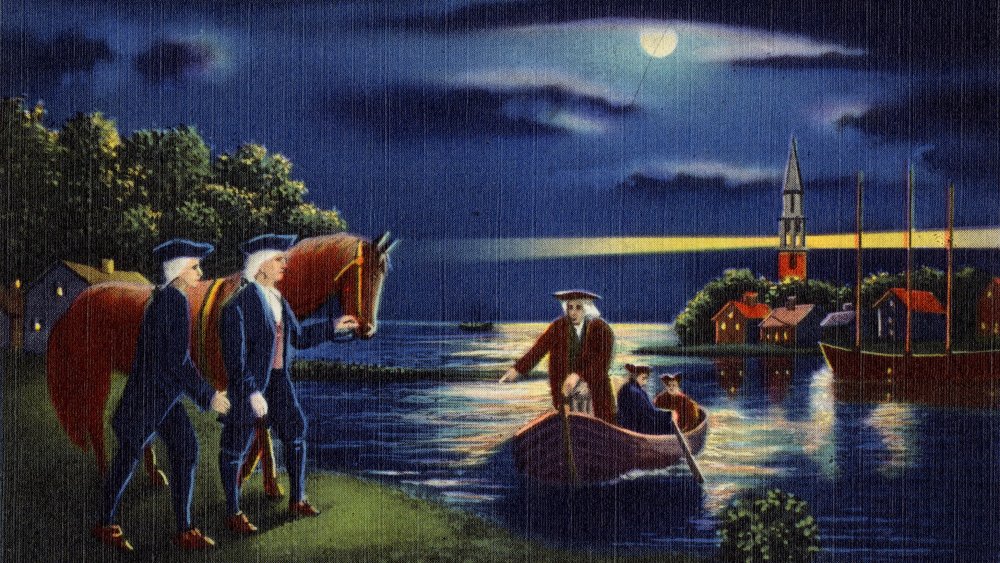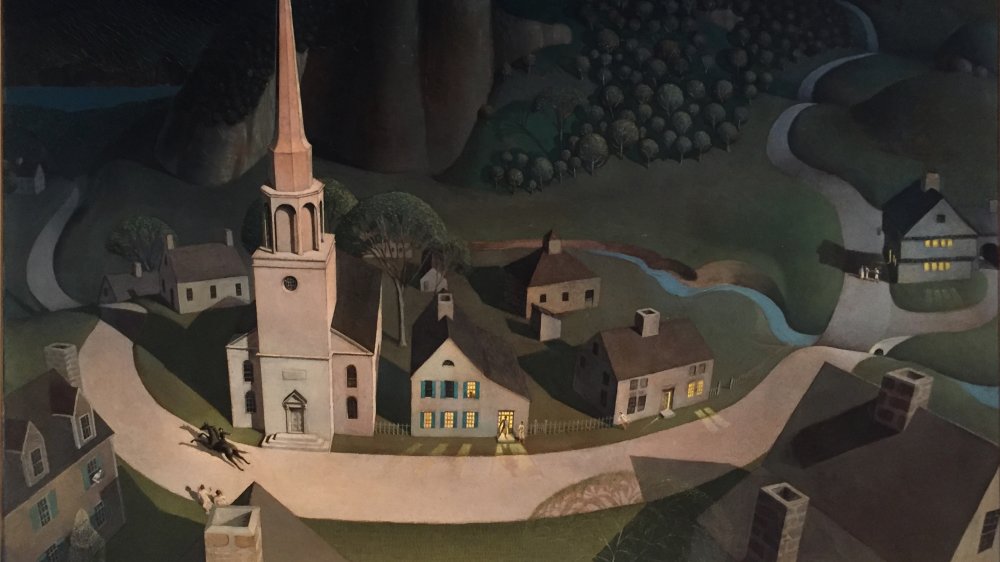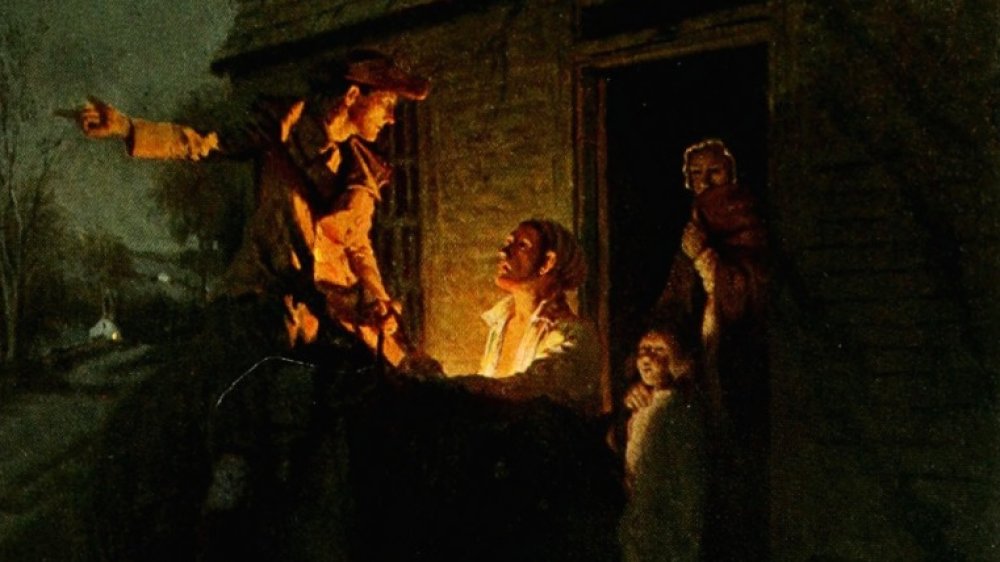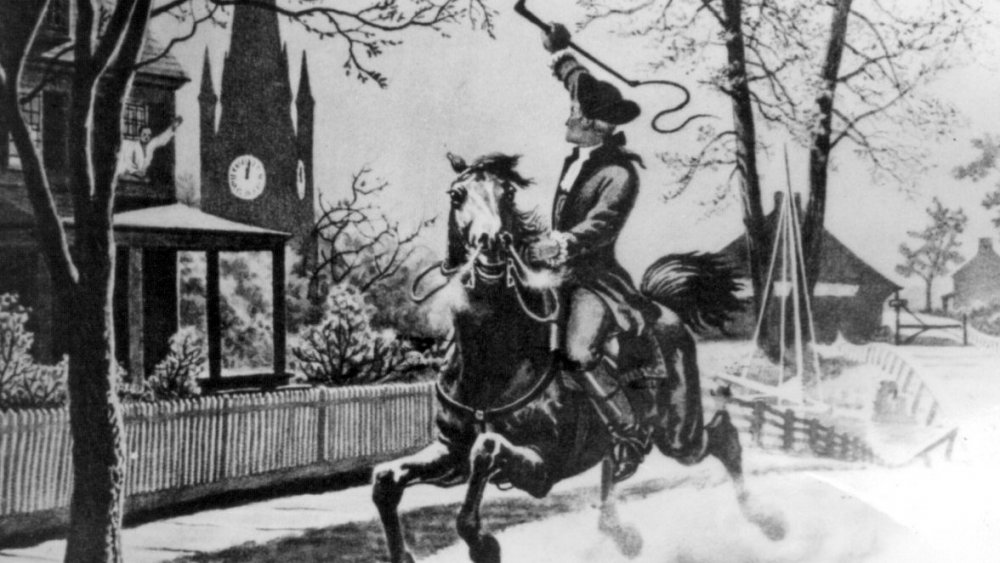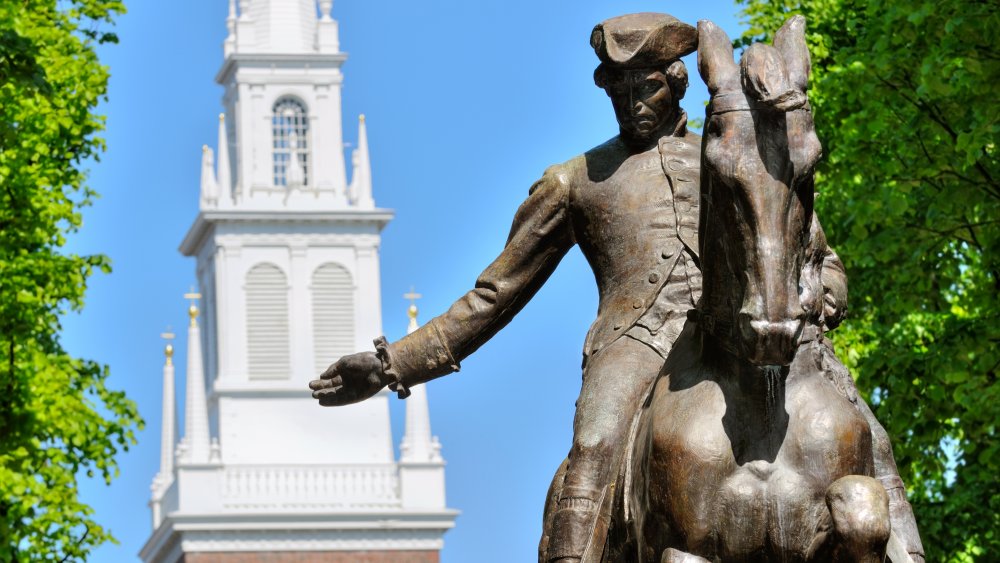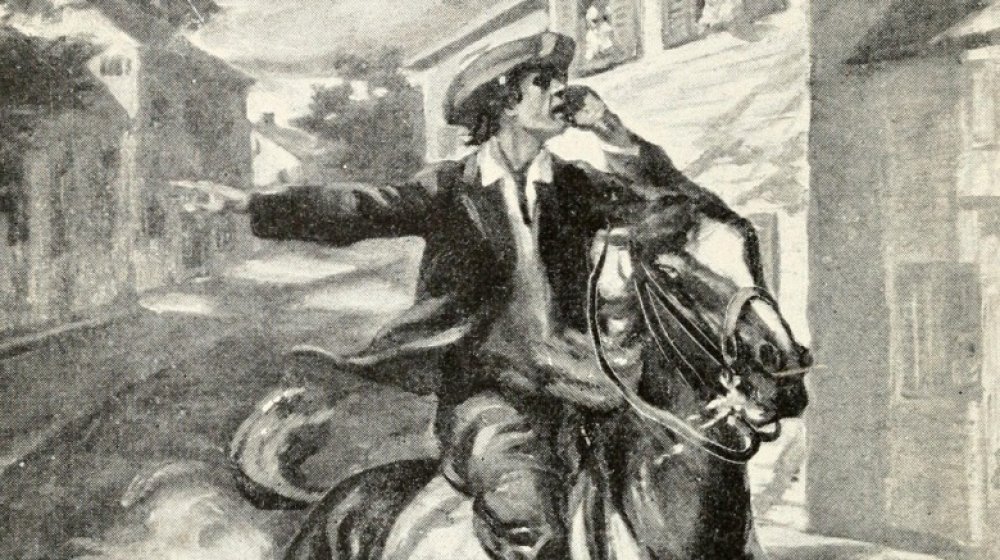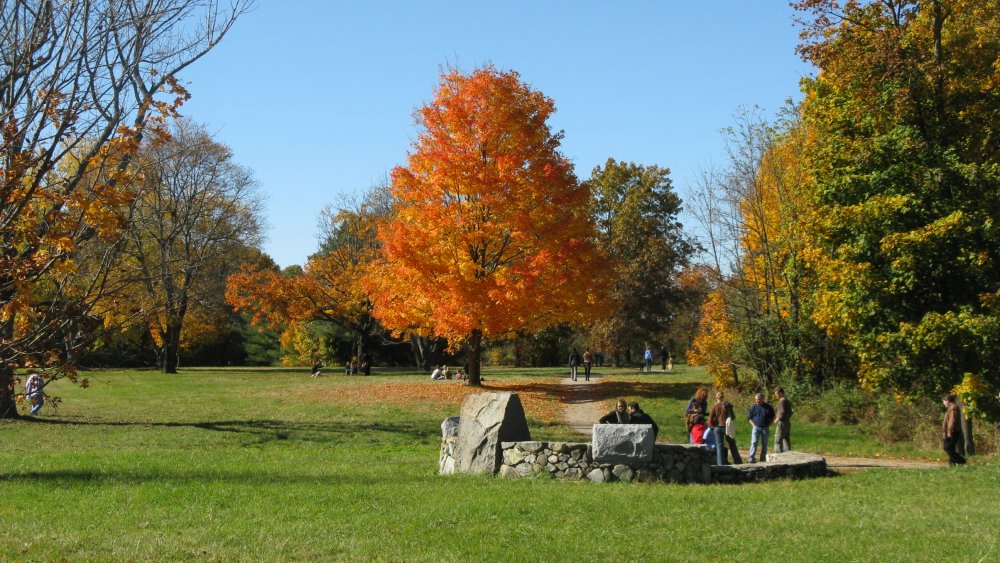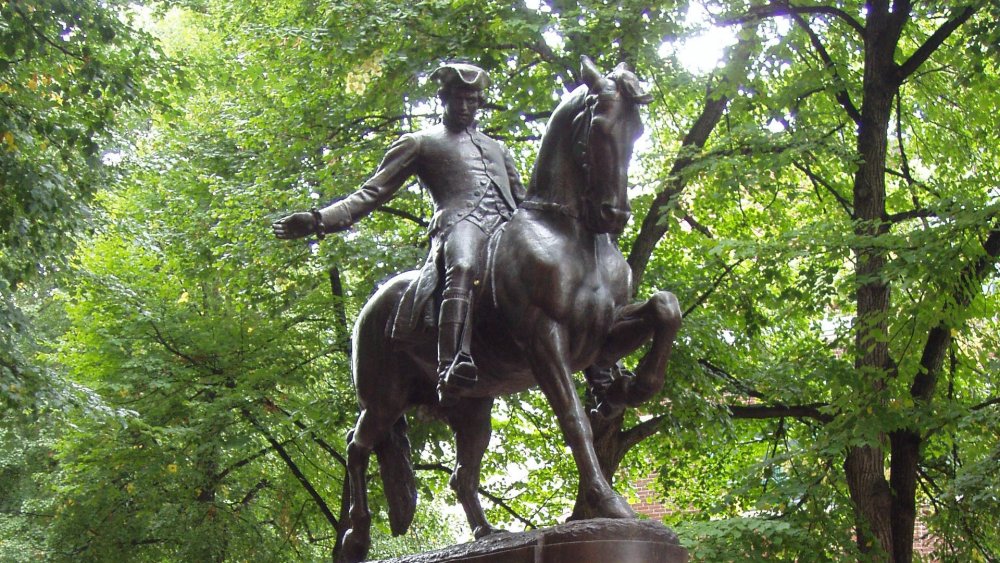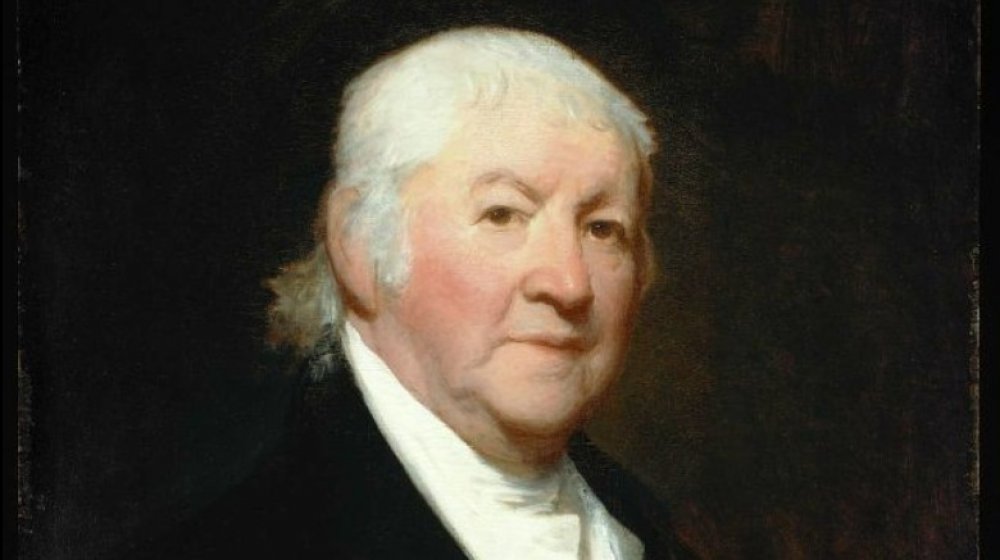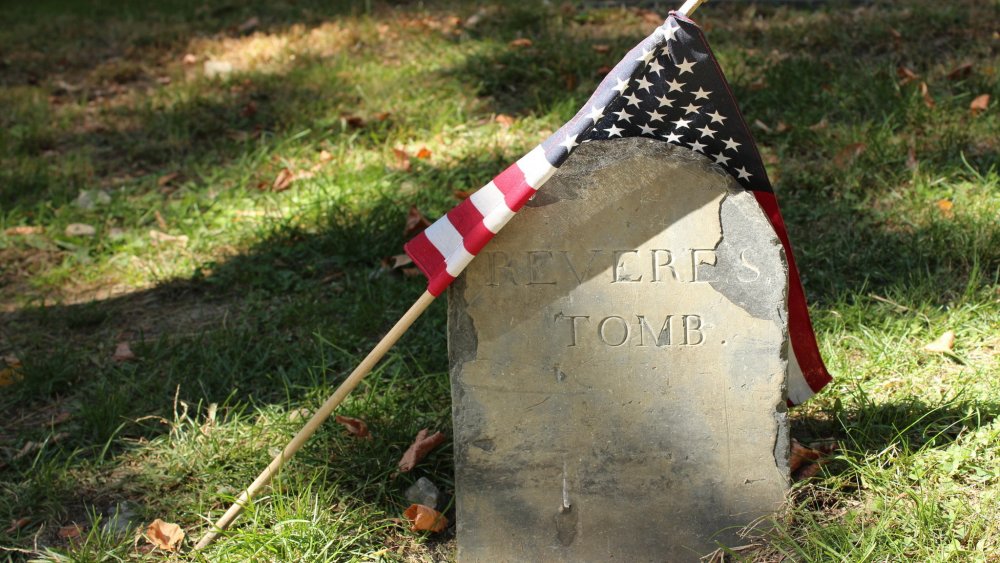False Things You Believe About Paul Revere
"Listen, my children, and you shall hear/Of the midnight ride of Paul Revere." So begins one of the most famous poems in American history, which tells the story of a lone patriot who sped through the night, warning sleeping colonial farmers of the dangers they faced from an encroaching British army. The image of a single man riding urgently through darkened streets sounding out an alarm has become an indelible part of common understanding of the beginnings of the American Revolution. But how much of it is accurate?
As is usually the case, there is much more to Paul Revere than just his famous midnight ride, which itself didn't happen quite the way most people imagine it. Revere was an artisan, family man, propagandist, spy, businessman, social butterfly, and more. He didn't ride alone, and his bravery wasn't as celebrated in his lifetime as you might expect. Here are some common misconceptions about the Revolution's midnight rider, Paul Revere.
Why are there so many myths about Paul Revere?
Paul Revere is undoubtedly an icon of the American Revolution, not only being one of the best-known names of that period but also sticking around through such pop cultural touchstones as 1960s rock band Paul Revere and the Raiders, an eponymous Beastie Boys song, and appearances in the Sleepy Hollow television series and Assassin's Creed series of video games. But this wasn't always the case. Revere's star didn't really rise until 95 years after his legendary ride, thanks to the hugely popular poem "Paul Revere's Ride" by Henry Wadsworth Longfellow.
According to the Paul Revere Heritage Project, on the eve of the American Civil War, Longfellow was attempting to spur patriotism by reminding Americans of their heroic revolutionary forebears. In order to promote unity and enforce the need for heroic sacrifice in a time of civil unrest, Longfellow plucked Revere from relative obscurity and used his considerable poetic ability to turn him from an ordinary man into an epic figure of myth. Since Longfellow's smash-hit poem was most people's introduction to Revere's midnight ride, the dramatized, simplified version of the story became the one most people knew. While Longfellow was always trying to write myth and not history, he was the unwitting source of most modern misconceptions about Paul Revere.
Revere's midnight ride was his only notable patriotic action
Because most people's conception of Paul Revere comes from Longfellow's 1860 poem which focuses singularly on the events of the night of April 18, 1755, Revere's ride is the only action for which the man is widely known. As the Paul Revere House points out, however, the events of that fateful night are only a blip within a life full of notable contributions to industry, politics, and public service.
It's generally known that Revere's primary occupation was as a silversmith, and this is true. His hugely successful shop was well-regarded for the quality of its intricate work at the time and still is today. However, his shop also included copper plates for engravings, through which Revere produced, among a broad range of other things, political illustrations, including a famous engraving of the Boston Massacre.
Revere's business connections led to his involvement in political affairs, including joining the Sons of Liberty and working as a spy and courier for multiple revolutionary committees, delivering messages directly to the Continental Congress in Philadelphia. He was also a member of the North Caucus, which organized and led protests against the British East India Company's tea shipments to keep the company from delivering its tea directly to colonists, bypassing colonial merchants. When this protest escalated into dudes just straight-up dumping the tea into the harbor (you might have heard about this), Revere was one of the ringleaders.
He received the signal "One if by land, two if by sea"
One of the best-known phrases from "Paul Revere's Ride" comes from the early stanzas where Revere tells his friend how to signal him with lights from the tower of the Old North Church when he knows how the British army is approaching: "One if by land, and two if by sea:/And I on the opposite shore will be,/Ready to ride and spread the alarm." The phrase "one if by land, two if by sea" is so well-known that people might recognize it even if they don't associate it with Revere but only the poorly reviewed 1995 Sandra Bullock/Denis Leary romantic comedy vehicle Two If by Sea.
But as much as the poem has engraved in popular consciousness the image of Revere "booted and spurred" awaiting the signal before rushing into action, as Biography points out, Longfellow actually reversed the truth of the signal for dramatic effect. While there were two lanterns hung in the church tower as a signal that the British army was approaching via the Charles River, this was not a signal to Revere from his accomplice but rather a signal from Revere himself to the Sons of Liberty in Charlestown. As it turns out, the lantern signal was an intentional redundancy because Revere was worried he would be caught before he could leave Boston. His own success made the "two if by sea" unnecessary.
Paul Revere rode alone
The popular image of Paul Revere fostered by Longfellow's poem is that of a single rider racing through the towns and villages of Massachusetts, rousing every patriotic citizen to action against the encroaching British army. This is, of course, an exaggeration and dramatization by Longfellow, who, in hopes of spurring on American nationalist sentiment, wanted to present the image of a bold, quintessentially American (or so Americans believe), rugged individual daring to stand up to an entire empire on his own. The truth of the matter, as is so often the case, is more complicated.
As Biography explains, Revere was merely a single piece in a much larger, very elaborate system of couriers and warning signals put in place by the Sons of Liberty. He wasn't even the only rider out that night. Dr. Joseph Warren, a friend of Revere's and a leader of the Patriots in Boston, summoned Revere to send warning to Samuel Adams and John Hancock in Lexington, but by that time, he had already sent another rider, William Dawes, by the longer land route (the one that would have led to one lantern in the church tower if the British had taken it). Revere and Dawes would meet up later in Lexington, where they would be joined by a third rider, Dr. Samuel Prescott. Pretty much the reason you don't know these guys is that fewer words rhyme with "Prescott" than "Revere."
Revere was a brooding loner of singular purpose and action
The seventh stanza of Longfellow's "Paul Revere's Ride" describes the eponymous midnight rider like this: "Meanwhile, impatient to mount and ride,/Booted and spurred, with heavy stride,/On the opposite shore walked Paul Revere," while the final stanza portrays "A cry of defiance, and not of fear,/A voice in the darkness, a knock at the door,/And a word that shall echo forevermore!" Lines like these portray Revere as a solitary, individualistic hero of singular purpose who, working on his own, saved a nation. All he needed was a good horse and one friend (who doesn't even get a name) to light some lanterns for him. For Longfellow, such a message was key in the face of a looming Civil War, i.e., you, the reader, by the power of your individual action, have the power to steer the course of a nation, you handsome smoldering, brooding loner, you.
But according to The New York Times, Revere was anything but a loner. Besides the fact that Revere was only one of a system of riders on that fateful night, the famous midnight rider was also famously social. The revolutionary movement in the colonies was splintered and isolated. Some 83% of dedicated revolutionary members belonged to merely one each of the seven major factions in Boston. Paul Revere, on the other hand, belonged to five of these groups. The dude was a social butterfly of American independence.
He rode his horse into history
The iconic image of Paul Revere is a simple one, with only a few essential elements: a man, his horse, and maybe a bell and a three-cornered hat. But while Revere presumably did own a hat and, as a metal worker, probably had a bell somewhere in his possession, there was one thing he didn't have: a horse. Well, that is to say, he did ride a horse on that fateful night in 1775 — it just wasn't his horse. He had to borrow one.
As the Paul Revere House points out, while Revere must have owned a horse at some point in his life in order to ride as deftly as he did, there's no evidence to support the idea that Revere had a horse of his own in April 1775. And even if he did have one, he wouldn't have wanted to ferry it with him across the Charles River in a rowboat to Charlestown to begin his ride. From Revere's own personal accounts of his ride, we know that he borrowed what he called "a very good horse" from a deacon named John Larkin, who may have, in fact, actually borrowed the horse from his father, Samuel Larkin, meaning that Revere's iconic ride was done on a third-hand horse. Larkin family records fortunately supply us with this historic horse's most likely name: "Brown Beauty."
Paul Revere shouted his warning throughout the streets
"So through the night rode Paul Revere;/And so through the night went his cry of alarm/To every Middlesex village and farm," says Longfellow's "Paul Revere's Ride," which also describes the sight and sound of Revere's horse's hoofs throwing up sparks on the cobblestone streets of Lexington and Concord. This description has created an indelible image of an urgent Revere shouting at the top of his lungs, riding at full speed, and maybe even ringing a bell to awaken every colonial farmer from his midnight sleep to gear up and be ready to resist the encroaching British army.
But it's important to remember that, as Biography tells it, Revere's task was essentially a spy mission, passing on actionable intelligence about an enemy, so secrecy was of considerable importance to avoid capture by British troops. Revere had to be rowed silently across the Charles River to avoid detection by the British warship HMS Somerset and only narrowly escaped capture by a British patrol outside of Charlestown. Rather than indiscriminately riding through town and shouting out his location and motivation, Revere rode from house to house, knocking on doors and passing on his warning. From many of these houses, other riders were dispatched to pass on the message in other directions. These riders then alerted the Minutemen and other militia members so that they could prepare in the town greens for invasion.
Paul Revere shouted "The British are coming!"
More than perhaps anything else, Paul Revere is associated with the well-known warning, "The British are coming!" which is what he allegedly yelled as he galloped his horse through New England in the middle of the night. However, like Darth Vader saying, "Luke, I am your father," or Marie Antoinette saying, "Let them eat cake," this is just one of those things that everyone "knows" happened that didn't actually happen.
As the American Battlefield Trust explains, American colonists before American independence would have rightly still thought of themselves as British, so telling someone that a group they considered themselves to be was coming would just be confusing. Contemporary reports, including Revere's own, relate that Revere's actual warning was "The Regulars are coming out," referring to the British regular army. In fact, according to Revere's own deposition about that night, when he arrived at the house where John Hancock and Samuel Adams were staying, the guard told him to stop making so much noise, to which Revere replied, "Noise! You'll have noise enough before long! The regulars are coming out!" The guard was still wary of this new arrival until John Hancock happened to overhear Revere's voice and say, "Oh, you, Revere. We are not afraid of you." Once inside, Revere was able to pass on his intelligence that troops were coming to arrest Hancock and Adams, which actually turned out to be a false report anyway.
Revere rode clear through to Concord
The heroic Revere of Longfellow's poem strides from town to town throughout Middlesex County warning patriots of danger. At midnight he crossed into Medford, at one he "galloped into Lexington," and finally, "It was two by the village clock,/When he came to the bridge in Concord town." It is here that Revere ends his ride, having successfully warned the local farmers so that when the Regulars arrived, they could give "them ball for ball,/From behind each fence and farmyard-wall." It's true that Lexington and Concord were the most significant destinations of Paul Revere's ride, as rebel leaders were stationed in Lexington and colonial weapons caches were in Concord, but contrary to the poem's narrative, Revere never made it to Concord.
According to the American Battlefield Trust, Revere and his comrades William Dawes and Samuel Prescott ran into a British patrol between Lexington and Concord. Dawes and Prescott evaded capture, but Revere by chance fled into the awaiting arms of a troop of soldiers. He was caught, detained, questioned, and threatened. They even took away his horse (well, his friend's dad's horse), and he had to return to Lexington on foot. While Revere aided Hancock and Adams in their escape, his famous ride ended there. It was Samuel Prescott who actually managed to reach Concord and warn the patriots there that the British were coming for their munitions stores.
Paul Revere looked like his famous statue in Boston
According to the Paul Revere Heritage Project, the equestrian statue of Revere near the Old North Church on Boston's Paul Revere Mall is one of the city's most photographed sculptures, an icon among even that historic city's landmarks. Constructed about 20 years after Revere was immortalized in verse, the statue depicts a bronze Revere on his midnight ride, not galloping at full force like you might expect but trotting along at a more dignified pace. This Revere cuts a heroic figure, looking dashing and trim in his tricorn hat and buttoned-up coat and vest. But the fact is, this depiction is as much a historical fantasy as Longfellow's poem, dramatizing and distorting fact to approach an intended emotional truth.
As told by American Heritage, rather than the hero of explosive action portrayed in popular depictions, the real Revere of April 1775 was a stout, middle-aged man concerned merely with getting his job done. After his midnight ride was over, Revere's own deposition describes him as struggling to drag John Hancock's trunk full of secret documents away from the encroaching regulars as musket balls whizzed past and smoke clouded his view. The perceived distance between "the rotund man of forty trudging away from the gunfire at Lexington" while doggedly carrying out his duty and the dashing rider on bronze horseback shows that there's more than one kind of hero.
Paul Revere's ride made him an instant American icon
Paul Revere's midnight ride has made him an immortal figure of the American Revolution, whose name is included among such luminaries as George Washington and Benjamin Franklin, and arguably more famous than significant figures such as John Dickinson, who co-authored the Constitution, or Abraham Woodhull, the spy who most likely uncovered Benedict Arnold's treason. It's reasonable, then, to assume that his bravery in alerting the Sons of Liberty to the invasion that would lead to the famous "shot heard 'round the world" made him an instant celebrity and icon of the Revolution, but it turns out this is simply not the case. The Paul Revere House explains that for 100 years after his most famous accomplishment, Revere was an obscure figure with only some local renown in the Boston area. It wasn't until the huge success of Longfellow's poem that he was plucked from obscurity and became a national hero.
In fact, Revere's 1818 obituary makes no mention whatsoever of the one thing he's famous for in modern times, focusing instead on his accomplishments as a businessman and his service to his country more vaguely. It also doesn't mention his 16 (!) children, which seems worth a note. It does, however, end with "Seldom has the tomb closed over a life so honorable and useful," which is the kind of sentiment we can all only hope to have in our obituaries.
Revere had an unassailable reputation for bravery
Make no mistake about it: Paul Revere was a brave dude. Riding through the night on a critical spy mission while evading capture by an imperial army, not revealing key information when you are captured and questioned, and then dodging bullets while dragging a giant trunk full of illegal documents all take a kind of fortitude that's not common among most people. But despite the heroism of Paul Revere's immortal night in 1775, his reputation for bravery wasn't always sacrosanct. In fact, after the war actually began, Revere was charged with cowardice and insubordination.
As History explains, in 1779, Revere led a unit of land artillery in the Penobscot Expedition, which ended disastrously. Revere and other American forces were tasked with stopping the construction of a British outpost in Maine, and the numbers were in the Americans' favor. The British, recognizing the strength of the American forces, were prepared to surrender, but the Americans waited so long to attack that there was time for British reinforcements to arrive, forcing an American retreat. Revere was court-martialed, charged with cowardice and insubordination, and made to resign from the militia. A later investigation in 1782 showed the charges against Revere were exaggerated and exonerated him, but the stain on his good name remained. Fortunately, no mention of this affair was made in Longfellow's poem, so no one today remembers it.
